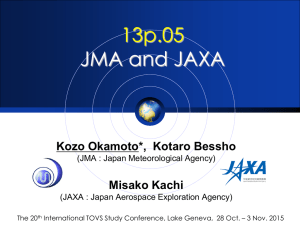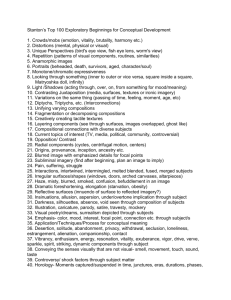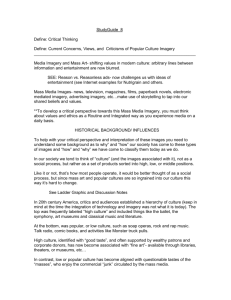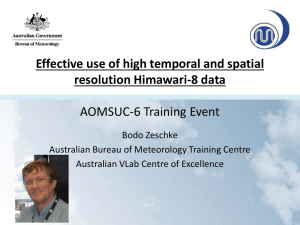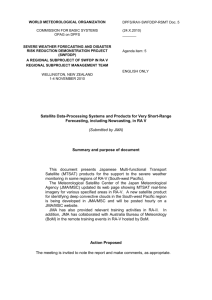Satellite data-processing systems and products for very short
advertisement
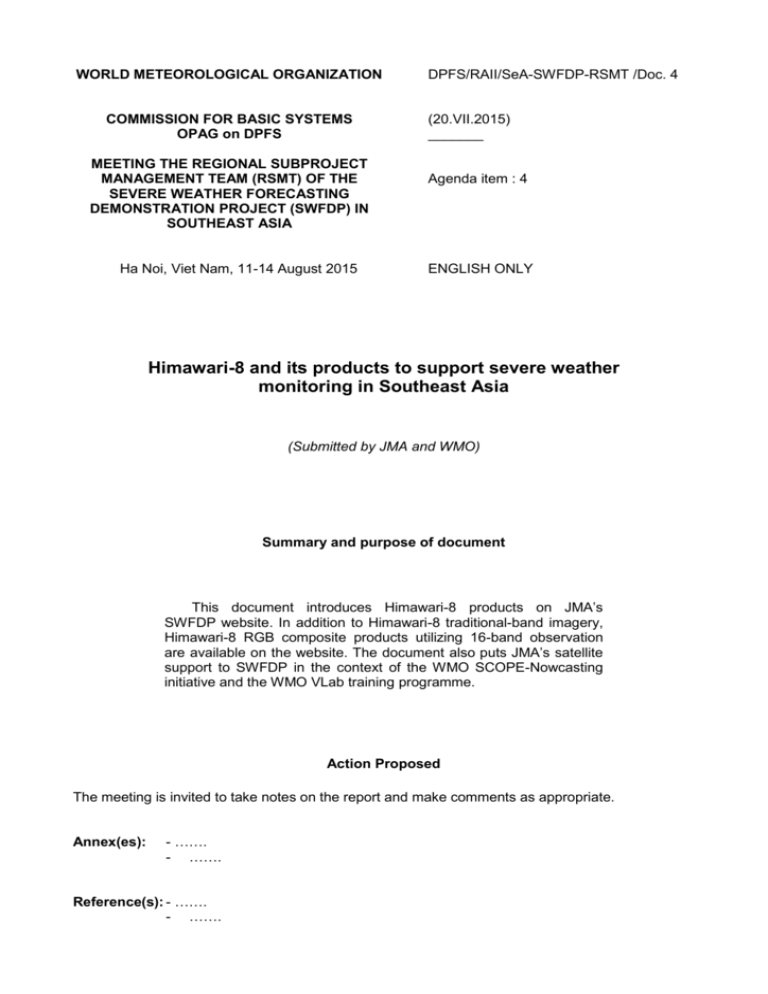
WORLD METEOROLOGICAL ORGANIZATION COMMISSION FOR BASIC SYSTEMS OPAG on DPFS MEETING THE REGIONAL SUBPROJECT MANAGEMENT TEAM (RSMT) OF THE SEVERE WEATHER FORECASTING DEMONSTRATION PROJECT (SWFDP) IN SOUTHEAST ASIA Ha Noi, Viet Nam, 11-14 August 2015 DPFS/RAII/SeA-SWFDP-RSMT /Doc. 4 (20.VII.2015) _______ Agenda item : 4 ENGLISH ONLY Himawari-8 and its products to support severe weather monitoring in Southeast Asia (Submitted by JMA and WMO) Summary and purpose of document This document introduces Himawari-8 products on JMA’s SWFDP website. In addition to Himawari-8 traditional-band imagery, Himawari-8 RGB composite products utilizing 16-band observation are available on the website. The document also puts JMA’s satellite support to SWFDP in the context of the WMO SCOPE-Nowcasting initiative and the WMO VLab training programme. Action Proposed The meeting is invited to take notes on the report and make comments as appropriate. Annex(es): - ……. - ……. Reference(s): - ……. - ……. DPFS/RAII/SeA-SWFDP-RSMT/Doc. XX, p. 2 1. Introduction Since the predawn of SWFDP in Southeast Asia, the Japan Meteorological Agency (JMA) has provided satellite imagery and products on JMA’s SWFDP website in compliance with users’ requests.These were MTSAT2-based real-time imagery, heavy rainfall potential areas, and RGB composites tailored to the SWFDP in Southeast Asia. JMA launched its geostationary meteorological satellite, Himawari-8, on 7 October 2014. After the testing and checking of Himawari-8 and related systems, JMA finally started Himawari-8 operation at 02:00 UTC on 7 July 2015, replacing the previous operational satellite, MTSAT-2. Himawari-9 will also be launched in 2016 as a backup and successor satellite. Both satellites are located around 140.7 degrees east, and observe the East Asia and Western Pacific regions for a period of 15 years. Himawari-8 and -9 have 16 bands, which is more than three times the 5 bands of the previous MTSAT series. Full-disk imagery is obtained every 10 minutes, and the target area observation at 2.5-minute intervals is conducted. Furthermore, the horizontal resolution is double that of the MTSAT series. These significant improvements opened the door to the new generation of satellite meteorology. This document shows Himawari-8 imagery and products provided on JMA’s SWFDP website. 2. Products for SWFDP in Southeast Asia As indicated above, Himawari-8 observes the earth with 16 bands. Each band has its own radiative characteristics. By allocating 3 bands to red, green and blue, then compositing the bands, RGB composite products are produced. RGB composite products are very useful to extract specific phenomena such as volcanic ash. In addition, 3 of 16 bands are visible bands corresponding to red, green and blue to enable the creation of true-color images.In this context, JMA follows the WMO guidance for generating RGB composite products1. JMA provides these products derived from Himawari-8 on JMA’s SWFDP website at http://www.wis-jma.go.jp/swfdp/ra2_swfdp_sea_sat.html. These products are updated every 10 minutes, which is quite high-frequency compared to 30/60 minutes of the previous MTSAT-2 satellite. Details of products are described below. 2.1 Traditional-band imagery (B03, B07, B08 and B13) JMA provides 4 bands imagery out of 16 observation bands on the website: visible imagery (B03), infrared imagery (B13), water vapor imagery (B08) and short-wave infrared imagery (B07). These 4 bands are traditional bands which general geostationary meteorological satellites such as JMA’s previous MTSAT-2 satellite carry. 1http://www.wmo.int/pages/prog/sat/documents/RGB-WS-2012_FinalReport.pdf Figure 1: Infrared imagery (B13) 2.2 True-color composite imagery True-color composite imagery is created with three visible bands corresponding to red, green and blue. This imagery looks as if human sees the earth from the space. This imagery is only available in the daytime. Figure 2: True-color composite imagery 2.3 Imagery with heavy rainfall potential areas Imagery with heavy rainfall potential areas provides information about the possibility of rainfall associated with deep convective clouds. Convective clouds detected from Himawari-8 data are colored in magenta and superimposed on infrared imagery. JMA has provided this product derived from MTSAT-2 data since 2012. The Himawari-8 based product has the approximately-same property as the MTSAT-2 based product because the Himawari-8 observation bands used to detect convective clouds are similar to the MTSAT-2 bands. Figure 3: Imagery with heavy rainfall potential areas 2.4 RGB composite products Utilizing Himawari-8 multi-band observation, JMA generates various RGB composite products in accordance with WMO standardprocedure. The website provides 7 RGB composite products: Air mass, Day natural color, Day microphysics, Convective storms, Night microphysics, Desert dust and Day solar. For example, Day natural color product makes easy to distinguish between high-level ice clouds and low-level water clouds since the former are colored in cyan and the latter in white. Figure 4: Day natural color product 2.5 Training in the use of satellite products Within the WMO Virtual Laboratory for Education and Training in Satellite Meteorology (VLab), JMA and BOM Australia have organized a number of online and classroom training events, introducing Himawari-8 imagery and the generation and analysis of imagery and products. The annual Asia-Oceania Meteorological Satellite Users Conferences are regularly used to organize such training events, and an excellent forum to exchange information and experiences (the 6thConference is organized on 9-13 November 2015 in Tokyo, Japan2). Since Himawari-8 is the first of the new generation of geostationary meteorological satellites, it is particularly important that stakeholders of the SWFDP Southeast Asia communicate their requirements for training on satellite data/products to JMA and WMOVLab. 3. Conclusion and future work As described at 2.4, RGB composite products are currently created using WMO standard procedure. JMA and leading agencies such as the Australian Bureau of Meteorology have a plan to collaborate in finding the optimized algorithms of RGB composition for Asia and Pacific regions. Feedbacks from users are absolutely welcome. JMA expects that Himawari-8 imagery including RGB composite products improves the monitoring and analysis techniques, and contributes to the prevention and mitigation of weatherrelated disasters in Southeast Asia. 2http://www.jma-net.go.jp/msc/en/aomsuc6/index.html

